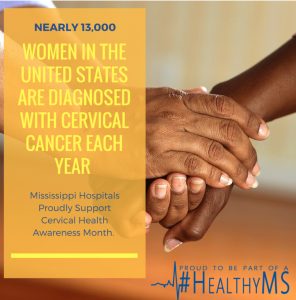 Cervical cancer was once a leading cause of cancer death for women in the U.S. Today, screening and prevention have greatly reduced the impact of this form of cancer. Still, more than 12,800 U.S. women received a diagnosis of cervical cancer and more than 4,200 died from the disease in 2017, according to the National Cancer Institute.
Cervical cancer was once a leading cause of cancer death for women in the U.S. Today, screening and prevention have greatly reduced the impact of this form of cancer. Still, more than 12,800 U.S. women received a diagnosis of cervical cancer and more than 4,200 died from the disease in 2017, according to the National Cancer Institute.
Increasing screening and prevention are key components of the effort to eradicate cervical cancer. Since almost all cases of the disease are caused by human papillomavirus (HPV) infection, vaccines that protect against the virus could prevent the vast majority of cases. Moreover, regular Pap tests can catch – and lead to treatment of – the disease at the precancerous stage.
Cervical cancer is among a number of cancers that can be caused by infections with pathogens – bacteria, viruses, and parasites, as explained in the AACR Cancer Progress Report 2017.
January is Cervical Cancer Awareness Month.
What is Cervical Cancer?
Cervical cancer is a disease in which cancer cells arise in the cervix, which connects the uterus to the vagina. HPV is almost always the cause of cervical cancer, which is why vaccines against the virus are an important part of cervical cancer prevention strategies.
In 2014, the U.S. Food and Drug Administration (FDA) announced the approval of a new vaccine—Gardasil 9—that prevents infection with five more cervical cancer-causing subtypes of HPV than the current HPV vaccines, Gardasil, and Cervarix.
In a study published in Cancer Epidemiology, Biomarkers & Prevention, a journal of the American Association for Cancer Research (AACR), researchers investigated the types of HPV infections in 12,514 women aged 15 to 45 and found that the seven subtypes of the virus targeted by Gardasil 9 accounted for about 91 percent of the most advanced cervical pre-cancers, meaning that Gardasil 9 could prevent nine out of 10 cases of cervical cancer.
“If vaccination programs with this new-generation vaccine are effectively implemented, approximately 90 percent of invasive cervical cancer cases worldwide could be prevented, in addition to the majority of precancerous lesions,” said senior author Elmar A. Joura, MD, an associate professor of gynecology at the Medical University of Vienna in Austria.
But there is a lack of public awareness and adherence to vaccination programs in the U.S. The Centers for Disease Control and Prevention (CDC) recommends vaccination for girls and boys ages 11 to 12.
A 2015 article in Cancer Epidemiology, Biomarkers & Prevention reported on a national survey that found many pediatricians and primary care physicians communicate about HPV vaccination in ways that may discourage parents from getting their children vaccinated.
“We are currently missing many opportunities to protect today’s young people from future HPV-related cancers,” said Melissa B. Gilkey, PhD, the article’s lead author and an assistant professor of population medicine at Harvard Medical School and Harvard Pilgrim Health Care Institute in Boston.
Usually cervical cancer develops slowly over time, and another powerful preventive measure is Pap test screening, a procedure during which cells are collected from the surface of the cervix and examined. The Pap test can both detect cancer at an early stage, when treatment outcomes tend to be better, and detect precancerous abnormalities, which can then be treated to prevent them from developing into cancers.
The AACR’s mission is to prevent and cure all forms of cancer.




